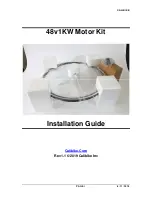
•
Read and understand the complete manual.
•
Adjust seat and handle‐bar height and tilt for best
comfort. Always make sure that minimum insertion
marks on seat post and handle‐stem e inserted into
frame so that marks are not visible.
•
Familiarize yourself with the controls and practise
braking and steering at low speeds in a flat, paved,
safe environment and always be prepared to apply
brakes in case of unexpected acceleration.
•
Do not switch on your bike on unless you are ready
to ride it to prevent accidental acceleration. Switch
bike off while pushing it. If you have any doubts
contact customer service.
Rules to ride safely
•
Cycling involves risk of injury and damage. By choosing to
ride this bicycle you assume the responsibility for that
risk.
•
This electric bike is intended only for riders 18 years or
older who are physically and mentally capable of riding
an electric bicycle. Consult your doctor to confirm
suitability of riding an ebike as impairments or disabilities
may increase the risk of injury or death. Parents and
guardians are responsible for the activities and safety of
children. This bike is not designed to be used by children.
•
Familiarise yourself with your local electric bicycle laws
as every state may have different regulations. Consult
your local authorities for advice.
•
Always ride carefully looking out for other participants in
traffic. Bicycles may be hard to see, therefore always ride
slowly and defensively always being ready to brake to
stop your bike. Use your bell.
•
Always avoid obstacles in the road like potholes or
curbs. If there are rail or tram tracks cross them at a 90
degree angle to avoid getting caught in the tracks and
losing control. Expect opening car doors or cars backing
out of driveways. Don’t use items which may restrict
your hearing.
Figure SO1: Stand‐over height:
To determine the
minimum leg‐length of the rider refer to the figure on the
left.
1: Top tube height of bicycle from ground. A straight top‐
tube is shown. Step‐through frames (sometimes referred
to as “Ladies” frames) are specified based on
corresponding straight top‐tube models.
2: Crotch measurement of rider: Wearing bicycle shoes
and having the feet 6 inches apart, measure the inside of
the leg from the ground to crotch.
3:
There should be at least 1 inch (25 mm) clearance
between the crotch measurement of the rider and the
top tube height of the bicycle when straddling the bike
.
For mountain bikes at least 2‐3 inches clearance is
recommended.
3
1
2
Before your first ride
Contact a customer service representative to assist you in finding a bike which has the right size for you. Important
measurements are the minimum and maximum seat height form the ground to the top of the seat and also the stand‐over
height.
•
Do not wear loose clothing which could get caught in the
moving parts of the bicycle.
•
Do not ride at night, in wet weather, icy conditions, snow
or other bad conditions like wind. Your braking power
will decrease and you will have less control over the bike
since the ground is more slippery.
•
Make sure that all your reflectors and lights are working
and installed correctly. Front and rear lights may increase
your visibility in conditions with low light,
however
reflectors only increase your visibility if light is pointed at
them. Wear high visibility clothing with bright and
reflecting materials.
WARNING!
Riding in low visibility conditions like night, dusk,
dawn or fog will increase your risk of collision as other
people may not see you.
Always think safety and apply common sense when riding.
Some examples are:
•
Do not ride when intoxicated, if you are impacted by
medication, extremely tired or if you do not feel
well. Always ride carefully and slowly being prepared to
stop the bike. Only ride on roads which are bicycle
friendly. Try to avoid roads with heavy traffic passing you
at a small distance.
•
Always keep your hands on the handlebar. If riding in a
group, ride in a single file, keep a safe distance from
other riders and generally try to avoid riding in a big
group as it may increase the risk of accidents.
•
Only one person should ride the bike. Do not carry a
second person on the bike. Riding off road will increase
the risk of damage or injury. Only ride on trails, do not
ride through water and avoid all obstacles. Make sure
that at no times obstacles hit any parts of your bike
including your bike stand. Always make sure that there is
enough clearance between the bike and the ground. Do
not attach loose objects to your bike.
•
Do not jump, do not perform stunts, do not ride over
obstacles like curbs, sticks and other obstacles, do not
ride in rough terrain, do not ride in an unusual manner.
WARNING!
Riding incorrectly can lead to damage and injury.
Always wear a helmet while riding
which complies with your local safety
standards.
5
© Leitner Pty Ltd 2019
Содержание Berlin 2020
Страница 25: ...25 Leitner Pty Ltd 2019 ...






































